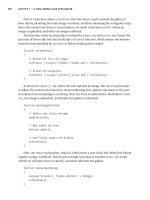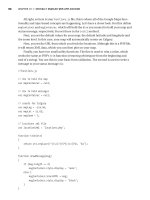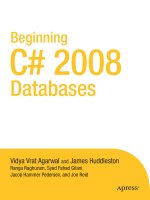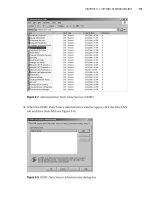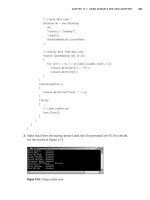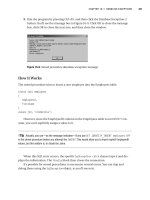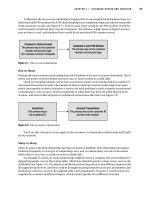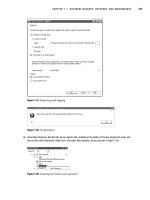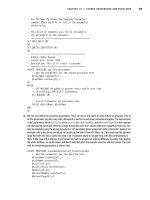Beginning Java SE 6 Platform From Novice to Professional phần 9 pot
Bạn đang xem bản rút gọn của tài liệu. Xem và tải ngay bản đầy đủ của tài liệu tại đây (425.5 KB, 51 trang )
XmlElementRefs Marks a property that refers to classes with XmlElement or
JAXBElement.
XmlElements Serves as a container for multiple @XmlElement annotations.
XmlElementWrapper Generates a wrapper element around the XML
representation of a collection.
XmlEnum Maps an enumeration type to its XML representation.
XmlEnumValue Maps an enumeration constant to its XML representation.
XmlID Maps a property to an XML identifier.
XmlIDRef Maps a property to an XML identifier reference.
XmlInlineBinaryData Specifies not to use XML-binary Optimized Packaging
(XOP) to encode data types (such as byte[]) that are bound
to base64-encoded binary data when representing the data
type (and its data) in XML.
XmlList Maps a property of java.util.List<E> type to its XML
representation.
XmlMimeType Associates the MIME type that controls a property’s XML
representation with the property.
XmlMixed Annotates a multivalued property to indicate that the
property supports mixed content.
XmlNs Associates a namespace prefix with an XML namespace
URI.
XmlRegistry Marks a class that contains XmlElementDecl annotations.
XmlRootElement Maps a class or an enumeration type to an XML element.
XmlSchema Maps a package name to an XML namespace.
XmlSchemaType Maps a Java type to a simple schema type.
XmlSchemaTypes Serves as a container for multiple @XmlSchemaType
annotations.
XmlTransient Prevents a property that does not participate in JAXB
serialization/deserialization from being mapped to an
XML representation.
XmlType Maps a class or an enumeration type to an XML Schema
type.
XmlValue Enables the mapping of a class to an XML Schema
complexType with nested simpleContent, or an XML
Schema simpleType.
javax.xml.bind.annotation. Uses an adapter based on javax.xml.bind.annotation.
adapters.XmlJavaTypeAdapter adapters.XMLAdapter for custom marshaling.
javax.xml.bind.annotation. Serves as a container for multiple @XmlJavaTypeAdapter
adapters.XmlJavaTypeAdapters annotations.
APPENDIX A ■ NEW ANNOTATION TYPES 385
Annotation Type Description
830-X XA.qxd 9/18/07 9:45 PM Page 385
Table A-2 describes JAX-WS annotation types. All of these types are located in the
javax.xml.ws package.
Table A-2. JAX-WS Annotation Types
Annotation Type Description
BindingType Specifies the binding to use for a web service endpoint implementation
class.
RequestWrapper Annotates those methods in the Service Endpoint Interface (SEI) with
the request wrapper bean that will be used at runtime.
ResponseWrapper Annotates those methods in the SEI with the response wrapper bean
that will be used at runtime.
ServiceMode Indicates whether a javax.xml.ws.Provider implementation works
with protocol messages in their entirety or just their payloads.
WebEndpoint Annotates the get
PortName() methods of a generated service interface.
WebFault Annotates service-specific exception classes to customize to the local
and namespace name of the fault element and the name of the fault
bean.
WebServiceClient Annotates a generated service interface.
WebServiceProvider Annotates a Provider implementation class.
WebServiceRef Defines a reference to a web service and (optionally) an injection target
for the web service.
WebServiceRefs Allows multiple web service references to be specified at the class level.
Table A-3 describes JWS annotation types. Those types not prefixed with a package
name are located in the
javax.jws package.
Table A-3. JWS Annotation Types
Annotation Type Description
HandlerChain Associates a web service with an external file that defines
a handler chain.
OneWay Indicates that a @WebMethod annotation has input
parameters only; there is no return value.
WebMethod Specifies that the method targeted by the @WebMethod
annotation is exposed as a public operation of the web
service.
WebParam Customizes the mapping between the web service’s
operation input parameters and elements of the
generated Web Services Description Language (WSDL)
file. The @WebParam annotation is also used to specify
parameter behavior.
APPENDIX A ■ NEW ANNOTATION TYPES386
830-X XA.qxd 9/18/07 9:45 PM Page 386
WebResult Customizes the mapping between the web service’s
operation return value and the corresponding element in
the generated WSDL file.
WebService Marks a Java class as implementing a web service, or a
Java interface as defining a web service.
javax.jws.soap.InitParam Deprecated as of JSR 181 version 2.0.
javax.jws.soap.SOAPBinding Specifies the mapping of a web service onto SOAP
(Service Oriented Architecture Protocol, also known as
Simple Object Access Protocol).
javax.jws.soap.SOAPMessageHandler Deprecated as of JSR 181 version 2.0.
javax.jws.soap.SOAPMessageHandlers Deprecated as of JSR 181 version 2.0.
Table A-4 describes JMX annotation types. These types are located in the javax.
management package.
Table A-4. JMX Annotation Types
Annotation Type Description
DescriptorKey Describes how an annotation element relates to a field in a javax.
management.Descriptor.
MXBean Explicitly marks an interface as being an MXBean interface or as not
being an MXBean interface.
Because the JDK documentation’s few annotation type examples are limited, you will
want to search the Internet for additional (and more developed) examples. For starters,
consider these two resources:
• Gautam Shah’s JavaWorld article, “Mustang: The fast track to Web services”
(
This
article discusses and illustrates various JWS annotation types.
• Sergey Malenkov’s blog entry, “How to use the @ConstructorProperties annotation”
(
/>This entry further develops the
Point class example in the JDK’s java.bean.
ConstructorProperties documentation.
APPENDIX A ■ NEW ANNOTATION TYPES 387
Annotation Type Description
830-X XA.qxd 9/18/07 9:45 PM Page 387
830-X XA.qxd 9/18/07 9:45 PM Page 388
New and Improved Tools
Java SE 6 includes several new and improved command-line tools. A command-line
script shell and tools for web services are examples of newly added tools. Tools that have
been improved include the Java archivist and the Java language compiler. In addition to
adding and improving various tools, Java SE 6 has enhanced its virtual machines and
their associated runtime environment. This appendix briefly describes the new and
improved Java SE 6 tools, as well as the virtual machine enhancements.
Basic Tools
The Java archivist (jar) and Java language compiler (javac) basic tools have been
improved in Java SE 6. Improvements range from adding a single new option to the
jar
tool, to migrating the annotation-processing tool (apt) functionality into javac.
(The
apt tool most likely will be removed from Java SE 7.)
■Note Java SE 6’s Java SE Development Kit (JDK) tools documentation for the Java application launcher
(
java) basic tool now documents the version:release option, which was undocumented in Java 5. Also,
the Java SE 6 documentation no longer presents the nonstandard
-Xdebug and -Xrunhprof options;
however, these options have not been removed from the
java tool. For example, if you specify java -
Xrunhprof classname
, where classname represents some application starting class, the message
Dumping Java heap allocation sites done will appear on the console. Also, the current
directory will include a java.hprof.txt file.
Enhanced Java Archivist
A new -e option has been added to the jar tool. Use this option to identify the class that
serves as the entry point into an application whose class files are bundled into an exe-
cutable JAR file. This option creates or overrides the
Main-Class attribute value in the JAR
file’s manifest file. It can be used when creating or updating the JAR file.
389
APPENDIX B
830-X XB.qxd 9/20/07 2:10 PM Page 389
Listing B-1 presents source code that you can use to see how the new -e option
works.
Listing B-1. Classes.java
// Classes.java
class ClassA
{
public static void main (String [] args)
{
System.out.println ("This is class A.");
}
}
class ClassB
{
public static void main (String [] args)
{
System.out.println ("This is class B.");
}
}
Follow these steps to try the example:
1. Compile the contents of Listing B-1:
javac Classes.java
2. Bundle the resulting class files into a Classes.jar file, with ClassB as the main
class:
jar cfe Classes.jar ClassB *.class
3. Execute Classes.jar:
java -jar Classes.jar
APPENDIX B ■ NEW AND IMPROVED TOOLS390
830-X XB.qxd 9/20/07 2:10 PM Page 390
You should see this output:
This is class B
4. To switch the entry-point class to
ClassA, combine -e with -u (update) and update the
JAR file’s class files (if their unarchived counterpart classes have changed) as well:
jar ufe Classes.jar ClassA *.class
This time, executing Classes.jar yields the following output:
This is class A
If you want to update the manifest without updating any classes, combine
-e with -i
(store index information, in the form of a META-INF/INDEX.LIST file, in the JAR file):
jar ie Classes.jar ClassA
The -e option is just one example of the many small but useful features that Java SE 6
introduces to make the developer’s life easier. You no longer need to unpack and rebuild
a JAR file when you want to update only the manifest’s
Main-Class attribute. Learn more
about this option from the JDK’s
jar documentation ( />docs/technotes/tools/solaris/jar.html).
Enhanced Java Language Compiler
Java SE 6’s version of the javac tool contains several enhancements. The biggest enhance-
ment is the ability to process a source file’s annotations, so that you no longer need to use
the nonstandard
apt tool. After creating an annotation and an annotation processor,
invoke
javac with the -processor option to load the processor, which processes all
instances of the annotation prior to compiling the source file.
Consider a Java application whose source code is organized into many classes. This
application is being built in an incremental fashion, where constructors and methods are
partially or completely stubbed out until they need to be completely implemented. The
@Stub marker annotation defined in Listing B-2 is used to identify those constructors and
methods that are still a work in progress.
APPENDIX B ■ NEW AND IMPROVED TOOLS 391
830-X XB.qxd 9/20/07 2:10 PM Page 391
Listing B-2. Stub.java
// Stub.java
import java.lang.annotation.*;
@Target({ElementType.METHOD, ElementType.CONSTRUCTOR})
public @interface Stub
{
}
This annotation is to be used with an annotation processor that outputs the names
of stubbed-out constructors and methods, as a reminder that there is still work to be
done. Essentially, the annotation processor looks for constructor and method elements
prefixed with the
@Stub annotation, and outputs their names. Listing B-3 provides its
source code.
Listing B-3. StubAnnotationProcessor.java
// StubAnnotationProcessor.java
import static javax.lang.model.SourceVersion.*;
import static javax.tools.Diagnostic.Kind.*;
import java.lang.annotation.*;
import java.util.*;
import javax.annotation.processing.*;
import javax.lang.model.element.*;
@SupportedAnnotationTypes("Stub")
@SupportedSourceVersion(RELEASE_6)
public class StubAnnotationProcessor extends AbstractProcessor
{
// The javac tool invokes this method to process a set of annotation types
// originating from the previous round of annotation processing. The method
// returns a Boolean value indicating whether (true) or not (false) the
// annotations are claimed. When annotations are claimed, they will not be
// subsequently processed.
APPENDIX B ■ NEW AND IMPROVED TOOLS392
830-X XB.qxd 9/20/07 2:10 PM Page 392
public boolean process (Set<? extends TypeElement> annotations,
RoundEnvironment roundEnv)
{
// If types generated by this round of annotation processing are subject
// to a subsequent round of annotation processing
if (!roundEnv.processingOver ())
{
Set<? extends Element> elements;
elements = roundEnv.getElementsAnnotatedWith (Stub.class);
Iterator<? extends Element> it = elements.iterator ();
while (it.hasNext ())
{
Element element = it.next ();
String kind = element.getKind ().equals (ElementKind.METHOD)
? "Method " : "Constructor ";
String name = element.toString ();
processingEnv.getMessager ().
printMessage (NOTE, kind+name+ " needs to be fully implemented");
}
}
return true; // Claim the annotations.
}
}
An annotation processor is required to implement the javax.annotation.processing.
Processor interface, to register itself with javac. Various methods in the Processor inter-
face inform
javac about the annotation processor’s capabilities. For example, Set<String>
getSupportedAnnotationTypes()
returns the names of annotation types supported by the
annotation processor. For convenience, you can subclass the
javax.annotation.
processing.AbstractProcessor class instead of implementing Processor.
You need to implement the
public abstract boolean process(Set<? extends
TypeElement> annotations, RoundEnvironment roundEnv) method only in the
AbstractProcessor subclass. javac invokes this method for each round of annotation
processing, to process a set of annotation types (described by
annotations) on element
types that originated in the previous round.
The
javax.annotation.processing.RoundEnvironment argument roundEnv provides a
boolean processingOver() method that returns true if types generated by this round are
not subject to another round of annotation processing. Its
Set<? extends Element>
APPENDIX B ■ NEW AND IMPROVED TOOLS 393
830-X XB.qxd 9/20/07 2:10 PM Page 393
getElementsAnnotatedWith(Class<? extends Annotation> a) method returns elements
annotated with the given annotation type.
StubAnnotationProcessor’s process() method is called twice. Because processingOver()
returns false for the first call, the set of all elements annotated with @Stub (Stub.class) is
output via the processor’s messager (an object that outputs messages to standard output,
a window, or whatever destination is defined by a
javax.annotation.processing.Messager
implementation).
The
process() method returns true to claim the annotations, which prevents these
annotations from being processed by a subsequent processor, as in
-processor
StubAnnotationProcessor,StubAnnotationProcessor2. Because no types were generated
in this round, the next call to
process() results in processingOver() returning true, so no
processing is performed.
Listing B-4 presents the source code for a
Calculator application with a single
stubbed-out constructor and single stubbed-out method.
Listing B-4. Calculator.java
// Calculator.java
import javax.swing.*;
public class Calculator extends JFrame
{
@Stub
public Calculator ()
{
super ("Calculator");
setDefaultCloseOperation (EXIT_ON_CLOSE);
// To do.
pack ();
setVisible (true);
}
@Stub
double doCalc (String expr)
{
return 0.0;
}
public static void main (String [] args)
APPENDIX B ■ NEW AND IMPROVED TOOLS394
830-X XB.qxd 9/20/07 2:10 PM Page 394
{
Runnable r = new Runnable ()
{
public void run ()
{
new Calculator ();
}
};
java.awt.EventQueue.invokeLater (r);
}
}
As an example of using StubAnnotationProcessor, compile Listings B-2 and B-3.
Then invoke
javac -processor StubAnnotationProcessor Calculator.java to load the
StubAnnotationProcessor class, and have it process all instances of @Stub prior to compil-
ing
Calculator.java. You should observe the following output, which reveals the work
that still needs to be done to complete this application.
Note: Constructor Calculator() needs to be fully implemented
Note: Method doCalc(java.lang.String) needs to be fully implemented
The
-processor option is just one of several new javac options for processing annota-
tions. Table B-1 describes all of these options.
Table B-1. javac Annotation-Processing Options
Option Description
-Akey[=value] Passes key–named options directly to annotation processors. The
options are not interpreted by javac.
-implicit:(class|none) Controls the generation of class files for implicitly loaded source files.
A source file is implicitly loaded if it defines a searched-for type that is
referenced from the source file being processed. Class files are
generated if -implicit:class is specified. To prevent class files from
being generated, specify -implicit:none. If this option is not specified,
class files are automatically generated. Furthermore, the compiler
presents a warning message stating that the implicitly found source file
is not subject to annotation processing, if its equivalent class file is
generated during annotation processing. This warning message is not
issued if either -implicit:class or -implicit:none is specified.
-proc:(none|only) Restricts the behavior of javac to compilation without annotation
processing (-proc:none) or to annotation processing without
compilation (-proc:only).
APPENDIX B ■ NEW AND IMPROVED TOOLS 395
Continued
830-X XB.qxd 9/20/07 2:10 PM Page 395
-processor class1 Specifies a comma-separated list of annotation processors to load and
[, class2, class3 ] run.
-processorpath path Specifies the path location of annotation processors. By default, the
classpath is searched.
-s dir Specifies the dir location where generated source files are placed.
-Xprefer:(newer|source) Determines which file to read when both a source file and a class file
are found for a type. If the -Xprefer option is not specified, or
if -Xprefer:newer is specified, the newer of the class file and source file
is chosen. If -Xprefer:source is specified, the source file is always
chosen.
-Xprint Prints a textual representation of types to aid debugging. An example is
javac –Xprint java.lang.String.
-XprintProcessorInfo Prints information about annotation processors that have run and the
annotations they have processed.
-XprintRounds Prints information about each round of annotation processing.
A lesser-known javac enhancement is support for the @SuppressWarnings annotation,
which tells the compiler to suppress various kinds of warnings. Although this annotation
debuted in Java 5, it was left unsupported in the compiler. After supporting
@SuppressWarnings in Java SE 6, Sun back-ported this support to Java 5, beginning
with update 6.
The
@SuppressWarnings annotation is especially useful for suppressing unchecked
warnings, which indicate that the compiler cannot ensure type safety, and typically occur
from mixing generic and raw types in legacy-code contexts. Casting to type parameters
also results in unchecked warnings, as demonstrated in Listing B-5’s trivial stack data-
structure class.
Listing B-5. Stack.java
// Stack.java
public class Stack<T>
{
private T [] items;
private int top;
@SuppressWarnings("unchecked")
public Stack (int size)
{
items = (T []) new Object [size];
APPENDIX B ■ NEW AND IMPROVED TOOLS396
Table B-1. Continued
Option Description
830-X XB.qxd 9/20/07 2:10 PM Page 396
top = -1;
}
public void push (T item) throws Exception
{
if (top == items.length-1)
throw new Exception ("Stack Full");
items [++top] = item;
}
public T pop () throws Exception
{
if (top == -1)
throw new Exception ("Stack Empty");
return items [top ];
}
}
The (T []) cast in items = (T []) new Object [size]; leads to an unchecked warning
because of a mismatch between the static and dynamic parts of the cast. The “What is
an ‘unchecked’ warning?” section in Angelika Langer’s Java Generics FAQ (
http://www.
angelikalanger.com/GenericsFAQ/FAQSections/TechnicalDetails.
html#What%20is%20an%20unchecked%20warning?) discusses this situation.
Because type safety has not been compromised, this warning is annoying.
Fortunately, the warning can be suppressed by annotating the element where it
occurs. With Java 5 update 6 and later versions, annotating
Stack’s constructor with
@SuppressWarnings("unchecked") results in the unchecked warning message not appearing
during compilation.
Command-Line Script Shell
Java SE 6 introduces jrunscript, an experimental command-line script shell tool to aid
the exploration of Java-to-scripting language communication. Use this tool to evaluate
one-line scripts, evaluate scripts interactively from standard input, or evaluate file-based
scripts. Although
jrunscript defaults to JavaScript, this tool can be used with any accessi-
ble scripting language. Table B-2 lists its options.
APPENDIX B ■ NEW AND IMPROVED TOOLS 397
830-X XB.qxd 9/20/07 2:10 PM Page 397
Table B-2. jrunscript Options
Option Description
-classpath path Identifies the path locations of the user’s script-accessible class files.
-cp path A synonym for -classpath.
-Dname=value Sets a Java system property identified by name.
-Jflag Passes flag to the underlying virtual machine.
-l language Specifies an accessible scripting language to work with. JavaScript is the
default language.
-e script Evaluates a one-line script.
-encoding encoding Specifies the character encoding of a script file.
-f script-file Reads a script from a file and evaluates that script.
-f - Reads a script on a line-by-line basis from standard input and evaluates
each line.
-help Outputs a help message and exits.
-? A synonym for -help.
-q Lists all available script engines and exits.
This tool’s command-line syntax is jrunscript [options] [arguments ]. If options
are passed to
jrunscript, they must appear immediately after the command name. Any
arguments are specified after the command name or after
options. If you do not specify
options or arguments,
jrunscript executes in interactive mode:
jrunscript
js>Math.PI*20
62.83185307179586
js>cat("dumpargs.js")
for (i = 0; i < arguments.length; i++) println(arguments [i]);
If you specify at least one argument, and do not specify either the -e option or the -f
option, the first argument identifies a script file, and the remaining arguments are passed
to the script file. The file’s script can access these arguments via the predefined
arguments
array engine variable, which is a String array:
jrunscript dumpargs.js arg1 arg2
arg1
arg2
APPENDIX B ■ NEW AND IMPROVED TOOLS398
830-X XB.qxd 9/20/07 2:10 PM Page 398
If you specify -e (or -f) followed by the list of arguments, all arguments are passed to
the script:
jrunscript -e "for (i = 0; i < arguments.length; i++) println(arguments [i]);" ➥
dumpargs.js arg1 arg2
dumpargs.js
arg1
arg2
Finally, it is possible to evaluate the contents of a script file and then enter interactive
mode to continue evaluating scripts interactively:
jrunscript -f dumpargs.js -f - arg1 arg2
arg1
arg2
js>
You can learn more about jrunscript by reading Chapter 9 of this book and the JDK’s
jrunscript documentation ( />jrunscript.html).
Java Monitoring and Management Console
The Java monitoring and management console (JConsole) is a GUI-based application
for monitoring and managing running applications on local or remote platforms. The
jconsole command-line tool is used to launch JConsole.
Java SE 6 provides the ability to create custom JConsole plug-ins, such as the JTop
example plug-in that is bundled with the JDK. (JTop is used to monitor the CPU usage of
an application’s threads.) Java SE 6 also updates
jconsole with a new -pluginpath option,
which specifies a list of directories and/or JAR files to be searched for plug-ins. (These
plug-ins are subsequently loaded.)
Chapter 7 of this book provides a plug-in example. That chapter includes instruc-
tions for building the plug-in, packaging the plug-in into a JAR file, and running the
plug-in with
jconsole. Also, Chapter 2 discusses the ServiceLoader API, which jconsole
uses to load the -pluginpath option’s listed plug-ins.
APPENDIX B ■ NEW AND IMPROVED TOOLS 399
830-X XB.qxd 9/20/07 2:10 PM Page 399
Java Web Services Tools
By including a subset of the Java EE web services stack, Java SE 6 makes it easier for
developers to create web services. In addition to the web services stack, Java SE 6 has
introduced four new command-line tools for working with web services, as described in
Table B-3.
Table B-3. Tools for Web Services
Tool Description
schemagen Java Architecture for XML Binding (JAXB) schema generator. This tool generates a
schema file for each namespace that is referenced in your Java source files’ classes.
Check out the JDK documentation ( />technotes/tools/share/schemagen.html) for more information.
wsgen Web service generator. This tool is used with an end-point implementation class to
generate web service artifacts that allow a web service to be deployed. It is further
described in the JDK documentation ( />technotes/tools/share/wsgen.html).
wsimport Web service importer. This tool generates and compiles the web service artifacts
needed to import a web service to a web client. Check out the JDK documentation
( to
learn more about this tool.
xjc JAXB schema binding compiler. This tool transforms (binds) a source XML
schema to a set of JAXB content classes in the Java programming language.
More information about this tool is available in the JDK documentation
( />Chapter 10 of this book demonstrates wsgen and wsimport. Examples involving all four
tools can be found in The Java EE 5 Tutorial (
/>tutorial/doc/).
Java Web Start
Java Web Start (JWS), an implementation of Java Network Launching Protocol (JNLP),
allows users to download and launch Java applications without the hassle of complicated
installation procedures. From within a browser, the user runs an application by clicking a
link whose
.jnlp extension identifies a JNLP file. JWS first downloads the application if it
is not cached.
This technology addresses security concerns by allowing only trusted applications to
access various resources. It also lets users transparently run the latest application ver-
sions by automatically downloading these versions when users click their icons. If you
are new to JWS, check out these two resources:
APPENDIX B ■ NEW AND IMPROVED TOOLS400
830-X XB.qxd 9/20/07 2:10 PM Page 400
• The Java Tutorial’s “Java Web Start” lesson ( />tutorial/deployment/webstart/index.html) provides a good introduction to JWS.
• The JDK documentation’s Java Web Start Guide (
/>docs/technotes/guides/javaws/developersguide/contents.html) provides complete
information about JWS.
Java SE 6 has made many improvements to JWS and its
javaws launcher tool. Exam-
ples include enhanced icon support, and new
<java> and <update> elements. Also,
JNLPClassLoader has been rewritten to extend URLClassLoader. For a list of enhancements,
see Sun’s document “Java Web Start enhancements in version 6” (
/>javase/6/docs/technotes/guides/javaws/enhancements6.html).
Security Tools
Java SE 6 adds two new options to the keytool security tool, and two new options to the
jarsigner security tool.
New keytool Options
The keytool tool allows you to manage a keystore database of trusted cryptographic keys,
trusted certificates, and X.509 certificate chains. The following are the new
keytool options:
•
-genseckey: Generates a secret key (identified by an alias) and stores it in a keystore.
•
-importkeystore: Imports one or all entries from a source keystore into a destina-
tion keystore.
Learn more about these options from the JDK’s
keytool documentation (http://java.
sun.com/javase/6/docs/technotes/tools/solaris/keytool.html
).
New jarsigner Options
The jarsigner tool generates digital signatures for JAR files, and verifies the signatures
and integrity of signed JAR files. The following are the new
jarsigner options:
•
-digestalg: Overrides the message digest algorithm used when digesting a JAR file’s
entries. If
-digestalg is not specified, the default SHA-1 message digest algorithm is
used.
•
-sigalg: Overrides the signature algorithm used to sign the JAR file. If -sigalg is not
specified, the default SHA1withDSA or MD5withRSA algorithm (depending on the
type of the private key) is used.
APPENDIX B ■ NEW AND IMPROVED TOOLS 401
830-X XB.qxd 9/20/07 2:10 PM Page 401
Learn more about these options from the JDK’s jarsigner documentation (http://java.
sun.com/javase/6/docs/technotes/tools/solaris/jarsigner.html).
Troubleshooting Tools
Deadlocks, memory leaks, and other problems can occur while developing Java applica-
tions. To aid the developer in determining the cause of these problems, Java provides a
suite of experimental troubleshooting tools:
Java heap analysis tool (
jhat): This tool was introduced by Java SE 6 to browse a heap
dump. This snapshot is typically created by
jmap or jconsole. It supports a built-in
SQL-like Object Query Language (OQL) for querying heap dumps. It also includes
built-in queries for examining classes, objects that are pending finalization, and
more. Learn more about
jhat from the JDK documentation ( />javase/6/docs/technotes/tools/share/jhat.html).
Java configuration information (
jinfo): This tool outputs configuration information
(including Java system properties and virtual machine command-line flags) for a
Java process. Java SE 6 introduces a new
-flag option for setting a virtual machine
option. For more information about
jinfo and -flag, consult the JDK documentation
(
/>Memory map (
jmap): This tool lets you obtain heap information for a Java process.
Under Java SE 6, the Windows version of this tool now supports the
-dump and
-histo options. You can find more information about jmap and the new options in the
JDK documentation (
/>jmap.html).
Stack trace (
jstack): This tool outputs a Java process’s stack traces of all threads (Java
and native) attached to the virtual machine, which is useful in detecting deadlocks.
Starting with Java SE 6,
jstack is supported on Windows. Check out the JDK docu-
mentation (
/>to learn more about
jstack.
It is great to finally have access to the
jstack tool on Windows platforms, which makes
it so much easier to find out where an application’s threads have deadlocked. For example,
compile Listing B-6’s
Deadlock.java source code and run the resulting application.
APPENDIX B ■ NEW AND IMPROVED TOOLS402
830-X XB.qxd 9/20/07 2:10 PM Page 402
Listing B-6. Deadlock.java
// Deadlock.java
public class Deadlock
{
public static void main (String [] args)
{
new ThreadA ("A").start ();
new ThreadB ("B").start ();
}
}
class ThreadA extends Thread
{
ThreadA (String name)
{
setName (name);
}
public void run ()
{
while (true)
{
synchronized ("A")
{
System.out.println ("Thread A acquiring Lock A");
synchronized ("B")
{
System.out.println ("Thread A acquiring Lock B");
try
{
Thread.sleep ((int) Math.random ()*100);
}
catch (InterruptedException e)
{
}
System.out.println ("Thread A releasing Lock B");
}
System.out.println ("Thread A releasing Lock A");
}
}
}
}
APPENDIX B ■ NEW AND IMPROVED TOOLS 403
830-X XB.qxd 9/20/07 2:10 PM Page 403
class ThreadB extends Thread
{
ThreadB (String name)
{
setName (name);
}
public void run ()
{
while (true)
{
synchronized ("B")
{
System.out.println ("Thread B acquiring Lock B");
synchronized ("A")
{
System.out.println ("Thread B acquiring Lock A");
try
{
Thread.sleep ((int) Math.random ()*100);
}
catch (InterruptedException e)
{
}
System.out.println ("Thread B releasing Lock A");
}
System.out.println ("Thread B releasing Lock B");
}
}
}
}
Each thread will eventually acquire each other’s lock and cannot proceed—the appli-
cation is deadlocked. When this happens, open another command window and run the
jps monitoring tool to obtain Deadlock’s process ID. Pass this ID to jstack (as in jstack
pid) to output stack traces:
2007-05-15 15:37:46
Full thread dump Java HotSpot(TM) Client VM (1.6.0-b105 mixed mode):
"DestroyJavaVM" prio=6 tid=0x00296000 nid=0xe68 waiting on condition [0x00000000
0x0090fd4c]
APPENDIX B ■ NEW AND IMPROVED TOOLS404
830-X XB.qxd 9/20/07 2:10 PM Page 404
java.lang.Thread.State: RUNNABLE
"B" prio=6 tid=0x0aae3800 nid=0x9a8 waiting for monitor entry [0x0ae4f000
0x0ae4fd14]
java.lang.Thread.State: BLOCKED (on object monitor)
at ThreadB.run(Deadlock.java:58)
- waiting to lock <0x06b42948> (a java.lang.String)
- locked <0x06b43200> (a java.lang.String)
"A" prio=6 tid=0x0aae2800 nid=0xb3c waiting for monitor entry [0x0adff000
0x0adffd94]
java.lang.Thread.State: BLOCKED (on object monitor)
at ThreadA.run(Deadlock.java:26)
- waiting to lock <0x06b43200> (a java.lang.String)
- locked <0x06b42948> (a java.lang.String)
"Low Memory Detector" daemon prio=6 tid=0x0aabc800 nid=0xac0 runnable [0x00000000
0x00000000]
java.lang.Thread.State: RUNNABLE
"CompilerThread0" daemon prio=10 tid=0x0aab7c00 nid=0x628 waiting on condition
[0x00000000 0x0ad0f71c]
java.lang.Thread.State: RUNNABLE
"Attach Listener" daemon prio=10 tid=0x0aab6800 nid=0xc24 waiting on condition
[0x00000000 0x00000000]
java.lang.Thread.State: RUNNABLE
"Signal Dispatcher" daemon prio=10 tid=0x0aab5800 nid=0xad0 runnable [0x00000000
0x00000000]
java.lang.Thread.State: RUNNABLE
"Finalizer" daemon prio=8 tid=0x0aaa6800 nid=0x350 in Object.wait() [0x0ac1f000
0x0ac1fc94]
java.lang.Thread.State: WAITING (on object monitor)
at java.lang.Object.wait(Native Method)
- waiting on <0x02e80288> (a java.lang.ref.ReferenceQueue$Lock)
at java.lang.ref.ReferenceQueue.remove(ReferenceQueue.java:116)
- locked <0x02e80288> (a java.lang.ref.ReferenceQueue$Lock)
at java.lang.ref.ReferenceQueue.remove(ReferenceQueue.java:132)
at java.lang.ref.Finalizer$FinalizerThread.run(Finalizer.java:159)
APPENDIX B ■ NEW AND IMPROVED TOOLS 405
830-X XB.qxd 9/20/07 2:10 PM Page 405
"Reference Handler" daemon prio=10 tid=0x0aaa2000 nid=0xf5c in Object.wait()
[0x0abcf000 0x0abcfd14]
java.lang.Thread.State: WAITING (on object monitor)
at java.lang.Object.wait(Native Method)
- waiting on <0x02e7bf40> (a java.lang.ref.Reference$Lock)
at java.lang.Object.wait(Object.java:485)
at java.lang.ref.Reference$ReferenceHandler.run(Reference.java:116)
- locked <0x02e7bf40> (a java.lang.ref.Reference$Lock)
"VM Thread" prio=10 tid=0x0aa9f000 nid=0xe40 runnable
"VM Periodic Task Thread" prio=10 tid=0x0aabe000 nid=0xa5c waiting on condition
JNI global references: 624
Found one Java-level deadlock:
=============================
"B":
waiting to lock monitor 0x0aaa32ec (object 0x06b42948, a java.lang.String),
which is held by "A"
"A":
waiting to lock monitor 0x0aaa3284 (object 0x06b43200, a java.lang.String),
which is held by "B"
Java stack information for the threads listed above:
===================================================
"B":
at ThreadB.run(Deadlock.java:58)
- waiting to lock <0x06b42948> (a java.lang.String)
- locked <0x06b43200> (a java.lang.String)
"A":
at ThreadA.run(Deadlock.java:26)
- waiting to lock <0x06b43200> (a java.lang.String)
- locked <0x06b42948> (a java.lang.String)
Found 1 deadlock.
APPENDIX B ■ NEW AND IMPROVED TOOLS406
830-X XB.qxd 9/20/07 2:10 PM Page 406
The output identifies a deadlock scenario during one execution of the Deadlock appli-
cation. It reveals where this application’s threads ran into trouble (the source lines are
bolded in Listing B-6), which monitor each thread was waiting to lock, and which locked
monitor was held by each thread.
Virtual Machine and Runtime Environment
In addition to providing new and improved tools, Java SE 6 enhances its virtual machines
and their runtime environment. These consist of performance-related enhancements
(identified in Appendix C), along with the following:
New classpath wildcards: A classpath entry can contain a wildcard character (
*) to
represent all files in the directory that end with the
.jar or .JAR extension. Examine
the JDK documentation for setting the classpath (
/>6/docs/technotes/tools/solaris/classpath.html) to learn more about this
enhancement.
Split verifier: According to JSR 202: Java Class File Specification Update
(
the pre-Java SE 6 class verifier’s algo-
rithm for determining a class file’s correctness has a memory overhead and impacts
performance at runtime. Because these expenses are significant to small devices,
Sun’s Connected Limited Device Configuration (CLDC) team split verification into
two phases: the compile-time phase adds extra
StackMap attributes to the class file;
the runtime phase uses these attributes to perform final verification. Because the
“split verifier” causes classes to load faster (and has other benefits), Java SE 6
includes a split verifier that is partly implemented in the
javac tool and partly imple-
mented in the virtual machine. You can learn more about Java SE 6’s split verifier by
reading java.net’s “New Java SE 6 Feature: Type Checking Verifier” (
.
java.net/verifier.html).
Better DTrace support: DTrace is Sun’s dynamic tracing framework for tuning and
troubleshooting Solaris-based applications. Java 5 introduced limited support for
DTrace in the Solaris-based virtual machines; this support has been extended in Java
SE 6. To learn more about the enhanced DTrace, read Jarod Jenson’s “DTrace and
Java: Exposing Performance Problems That Once Were Hidden” article (
x.
com/Java/Article/33943
) and the “Dynamic Tracing Support in the Java HotSpot
Virtual Machine” white paper (
/>java-dtrace-whitepaper.pdf).
APPENDIX B ■ NEW AND IMPROVED TOOLS 407
830-X XB.qxd 9/20/07 2:10 PM Page 407
Improved Java Native Interface (JNI): Java SE 6 brings a few enhancements to the JNI.
For starters, the
GetVersion() function now returns 0x00010006 (the value of the con-
stant defined by the new
JNI_VERSION_1_6 #define) to signify JDK/JRE 1.6. Also, a new
GetObjectRefType() function has been added to return its JObject argument’s type.
This argument can be a local, global, or weak global reference. Finally, the depre-
cated
JDK1_1InitArgs and JDK1_1AttachArgs structures have been removed; their
JavaVMInitArgs and JavaVMAttachArgs replacements structures are to be used instead.
Check out the JDK’s Java Native Interface Specification (
/>6/docs/technotes/guides/jni/spec/jniTOC.html) to learn more about these changes
and the JNI in general.
Improved JVM Tool Interface (JVM TI): Java SE 6 improves the JVM TI. Its improve-
ments are discussed in Chapter 7 of this book.
Improved Java Platform Debugger Architecture (JPDA): Java SE 6 enhances the JPDA.
The biggest change is the removal of the Java Virtual Machine Debug Interface, which
has been replaced by the JVM TI. (Because of the JVM TI, Java SE 6 also disables the
Java Virtual Machine Profiler Interface, which will be removed in the next release; see
Sun’s Java SE 6 Release Notes Compatibility page,
/>webnotes/compatibility.html.) A complete list of JPDA enhancements is available
in the JDK documentation (
/>jpda/enhancements.html).
■Note Garbage collection has also been enhanced in Java SE 6. Parallel compaction has significant
performance improvements (see
vm/par-compaction-6.html
). Also, the concurrent mark sweep collector has received several
enhancements (see />APPENDIX B ■ NEW AND IMPROVED TOOLS408
830-X XB.qxd 9/20/07 2:10 PM Page 408
Performance Enhancements
Each new release of the Java platform is expected to achieve better performance than
its predecessor. Java SE 6 does not disappoint. A lot of work has gone into making this
release perform better than Java 5. If you are having trouble convincing your manage-
ment to transition to Java SE 6, it might help to point out the performance enhancements
covered in this appendix.
A Fix for the Gray-Rect Problem
Java SE 6 fixes a long-standing problem with Swing. Prior to Java SE 6, exposing a Swing
window after obscuring this window resulted in a noticeable delay between the moment
when the window’s background was erased and its contents were painted. This is known
as the “gray-rect problem,” which can be demonstrated by running the application in
Listing C-1.
Listing C-1. GrayRectDemo.java
// GrayRectDemo.java
import java.awt.*;
import javax.swing.*;
public class GrayRectDemo extends JFrame
{
public GrayRectDemo ()
{
super ("Gray Rect Demo");
setDefaultCloseOperation (EXIT_ON_CLOSE);
// Cover the main window with a component that delays after painting its
// contents.
409
APPENDIX C
830-X XC.qxd 9/20/07 2:15 PM Page 409
